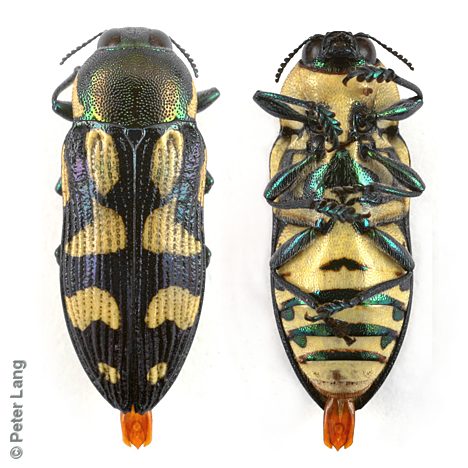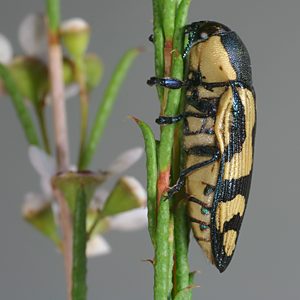










size¹:
×
4.8 mm











| male | female | |||||
|---|---|---|---|---|---|---|
| L1 | 12.3 | 8.75 – 15 | n = 77 | 13.6 | 9.8 – 16.1 | n = 40 |
| L2 | 12.6 | 9 – 14.6 | n = 25 | 14.1 | 11.3 – 15.95 | n = 16 |
| W | 4.6 | 3.25 – 5.5 | n = 77 | 5.2 | 3.7 – 6.3 | n = 40 |
| Legend | L1 | length from clypeus/frons to elytral apex (mean, range, sample size) |
| L2 | length from anterior of edge of eyes to elytral apex | |
| W | maximum width with elytra fully closed |
Ventral side yellow. Males in particular have very large and broad tarsi. Similar coloration to Castiarina decemmaculata with which it often occurs, but it is larger and has a broader body shape than that species.
This species was described by Hope 1846 'from the settlement at Adelaide'. It is similar and closely related to Castiarina octospilota of the eastern states.
It is a conspicuous spring species on Tea-tree (Leptospermum) flowers in the Adelaide foothills and central Hills area, as well as much further afield in places with heathy vegetation.
Forms from Kangaroo Island have heavier dark markings and often have two disjunct yellow lacunae in the anterior half of each elytron. On the mainland, forms with these lacunae conjoined are more common. Forms from the SE region have a richer yellow and stronger green reflections.
| Legend | P.J.Lang collection vouchered records | |
| other private collection or museum specimens, or sightings |
|
|
|
|
|
|
|
|
|
|
|
|
|
||||||||||||||||||||||||||||||||||||||||||||||||
|
|
|
|
|
|
|
|
|
|
|
|
|
||||||||||||||||||||||||||||||||||||||||||||||||
|
|
|
|
|
|
|
|
|
|
|
|
|
||||||||||||||||||||||||||||||||||||||||||||||||
| Jul | Aug | Sep | Oct | Nov | Dec | Jan | Feb | Mar | Apr | May | Jun |
| Legend | ||
9 | number of active beetles, actually recorded in that quarter-month | |
2 | estimate of active beetles, inferred* from adjoining date ranges | |
| actual count > 35 (median) | ||
| actual count <= 35 (median) | ||
| *Inferred when a site has counts of active beetles for each of two consecutive
periods (date ranges), one finishing and the other starting in the same
quarter-month. The count estimate is assigned to that quarter-month and calculated as the lower of the two total beetle counts, divided by the number of quarter-months in its date range. | ||
| beetles | sites | SA regions¹ | family | position on host plant | ||||||
| Leptospermum myrsinoides | 204 | 29 | SL, KI, SE | M | ||||||
| Leptospermum continentale | 153 | 19 | MU, SL, KI, SE | M | ||||||
| Leptospermum coriaceum | 108 | 22 | GT, EP, MU, SL, SE | M | ||||||
| Calytrix tetragona | 88 | 15 | MU, SL, KI, SE | M | ||||||
| Leptospermum sp. | 52 | 19 | MU, SL, KI, SE | M | ||||||
| Hysterobaeckea behrii | 19 | 9 | EP, MU, SL, SE | M | ||||||
| Melaleuca gibbosa | 4 | 2 | KI | M | ||||||
| Darwinia micropetala | 2 | 1 | KI | M | ||||||
| Acacia uncifolia | 1 | 1 | KI | F | ||||||
| Allocasuarina verticillata | 1 | 1 | SL | C | ||||||
| Banksia marginata | 1 | 1 | SL | P1 | ||||||
| Bursaria spinosa ssp. spinosa | 1 | 1 | KI | P2 | ||||||
| Calytrix glaberrima | 1 | 1 | KI | M | ||||||
| Eucalyptus incrassata | 1 | 1 | SE | M | ||||||
| Grevillea pterosperma | 1 | 1 | EP | P1 | ||||||
| Homoranthus wilhelmii | 1 | 1 | EP | M | ||||||
| Kunzea pomifera | 1 | 1 | SL | M | ||||||
| Melaleuca sp. | 1 | 1 | SL | M | ||||||
| Melaleuca uncinata | 1 | 1 | KI | M | ||||||
| Myrtaceae sp. | 1 | 1 | SE | M | ||||||
| Spyridium subochreatum | 1 | 1 | SE | R | ||||||
| Thryptomene ericaea | 1 | 1 | KI | M |
| Legend | beetles | count of beetles collected from, or sighted on, host plant taxon |
| sites | count of major sites (unique 10 km grid cells +/- some distinct approximate localities) | |
| Plant names in green are hyperlinked to a matching host species page with plant photos. | ||
| Code | beetles | % | host plant taxa | |
| M | Myrtaceae | 638 | 99% | 13 |
| P1 | Proteaceae | 2 | 0% | 2 |
| C | Casuarinaceae | 1 | 0% | 1 |
| F | Fabaceae | 1 | 0% | 1 |
| P2 | Pittosporaceae | 1 | 0% | 1 |
| R | Rhamnaceae | 1 | 0% | 1 |
| position | beetles | sites | ||
| on flower(s) | 396 | 55 | ||
| on flowering plant | 183 | 37 | ||
| on foliage or non-flowering plant | 1 | 1 | ||
| on plant (unspecified) | 62 | 23 | ||
| other | ||||
| in blue bucket | 1 | 1 | ||
| on stems | 1 | 1 | ||
| colour | beetles | sites | SA regions¹ | |
| blue | 148 | 6 | SL, KI, SE | |
| white | 145 | 3 | SL, SE | |
| light pink | 62 | 2 | SE | |
| red | 4 | 2 | SE | |
| light violet | 3 | 1 | SE | |
| purple-pink | 1 | 1 | SE |
| ¹ Legend | regions | SA State Herbarium regions (map) EA: Eastern, EP: Eyre Peninsula, FR: Flinders Ranges, GT: Gairdner-Torrens, KI: Kangaroo Island, LE: Lake Eyre, MU: Murray, NL: Northern Lofty, NU: Nullarbor, NW: North-Western, SE: South-Eastern, SL: Southern Lofty, YP: Yorke Peninsula |
| size | The ellipse is the correct size when printed, indicative on a desktop screen, and likely to be wrong on a mobile device. |